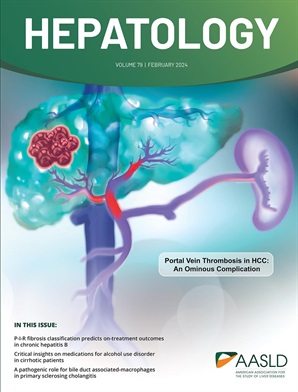Suppressing MASH fibrotic progression by blocking succinate-GPR91 signaling in hepatic stellate cells
IF 12.9
1区 医学
Q1 GASTROENTEROLOGY & HEPATOLOGY
引用次数: 0
Abstract
Background: The succinate receptor GPR91 is highly expressed in hepatic stellate cells (HSCs), with its expression further elevated during metabolic-dysfunction-associated steatohepatitis (MASH)-induced fibrotic progression. However, convincing in vivo data on whether blocking GPR91 signaling leads to fibrotic regression in MASH is lacking. Methods: MASH models were induced by choline-deficient amino acid-defined diet feeding along with lipopolysaccharide injection (CDAA-LPS) plus intraperitoneal injection of succinate or by high-fat and high-calorie diet plus high fructose and glucose in drinking water (HFCD-HF/G) in wild-type (WT) mice and HSC-specific GPR91 knockout (HSC-GPR91-KO) mice. Results: Administration of succinate significantly exacerbated fibrosis in CDAA-fed WT mice, as evidenced by increased collagen deposition and hydroxyproline levels along with an increased GPR91 expression in activated HSCs. Both WT and HSC-GPR91-KO mice exhibited substantial elevation in hepatic succinate levels upon HFCD-HF/G diet feeding. However, in comparison to HFCD+HF/G-fed WT mice, hepatic fibrosis was markedly ameliorated in HSC-GPR91-KO mice, as evidenced by diminished hepatic hydroxyproline content with downregulated fibrogenic markers. Succinate stimulation led to an increase in α-SMA, GPR91, phosphorylated ERK1/2, c-jun and Smad3 protein levels and enhanced the molecular interaction between c-jun and Smad3, inhibited forskolin-induced cAMP production in human HSCs, and increased p-NF-κB transcriptional activity, thereby suppressing HSC apoptosis. Conclusions: HSC-specific GPR91 receptor deficiency effectively halted hepatic fibrosis, probably through two distinct signaling pathways: suppressing the succinate-GPR91-Gβγ-ERK/c-jun-smad3 axis that positively regulates HSC activation; and abrogating the GPR91-Gαi-cAMP-NF-κB pathway that hinders their apoptosis. These findings confer GPR91 as a promising target for molecular interventions in blocking MASH-fibrotic progression.阻断肝星状细胞琥珀酸- gpr91信号通路抑制MASH纤维化进展
背景:琥珀酸受体GPR91在肝星状细胞(hsc)中高表达,在代谢功能障碍相关脂肪性肝炎(MASH)诱导的纤维化进程中其表达进一步升高。然而,关于阻断GPR91信号是否会导致MASH纤维化消退的令人信服的体内数据缺乏。方法:在野生型(WT)小鼠和hsc特异性GPR91敲除(HSC-GPR91-KO)小鼠中,采用胆碱缺乏氨基酸定义的日粮加脂多糖注射(CDAA-LPS)加琥珀酸酯腹腔注射或高脂肪高热量日粮加高果糖和高葡萄糖饮水(HFCD-HF/G)诱导MASH模型。结果:琥珀酸显著加重了cdaa喂养的WT小鼠的纤维化,这可以通过激活的hsc中胶原沉积和羟脯氨酸水平的增加以及GPR91表达的增加来证明。在饲喂HFCD-HF/G日粮后,WT和HSC-GPR91-KO小鼠肝脏琥珀酸盐水平均显著升高。然而,与HFCD+HF/ g喂养的WT小鼠相比,HSC-GPR91-KO小鼠的肝纤维化明显改善,肝羟脯氨酸含量降低,纤维化标志物下调。琥珀酸刺激导致α-SMA、GPR91、磷酸化ERK1/2、c-jun和Smad3蛋白水平升高,并增强c-jun与Smad3的分子相互作用,抑制福斯克林诱导的人HSC中cAMP的产生,增加p-NF-κB转录活性,从而抑制HSC凋亡。结论:HSC特异性GPR91受体缺乏有效阻止肝纤维化,可能通过两条不同的信号通路:抑制琥珀酸-GPR91- g - βγ- erk /c-jun-smad3轴,正向调节HSC激活;阻断阻碍细胞凋亡的gpr91 - g - α - i- camp - nf -κB通路。这些发现赋予GPR91作为分子干预阻断mash纤维化进展的有希望的靶点。
本文章由计算机程序翻译,如有差异,请以英文原文为准。
求助全文
约1分钟内获得全文
求助全文
来源期刊

Hepatology
医学-胃肠肝病学
CiteScore
27.50
自引率
3.70%
发文量
609
审稿时长
1 months
期刊介绍:
HEPATOLOGY is recognized as the leading publication in the field of liver disease. It features original, peer-reviewed articles covering various aspects of liver structure, function, and disease. The journal's distinguished Editorial Board carefully selects the best articles each month, focusing on topics including immunology, chronic hepatitis, viral hepatitis, cirrhosis, genetic and metabolic liver diseases, liver cancer, and drug metabolism.
 求助内容:
求助内容: 应助结果提醒方式:
应助结果提醒方式:


